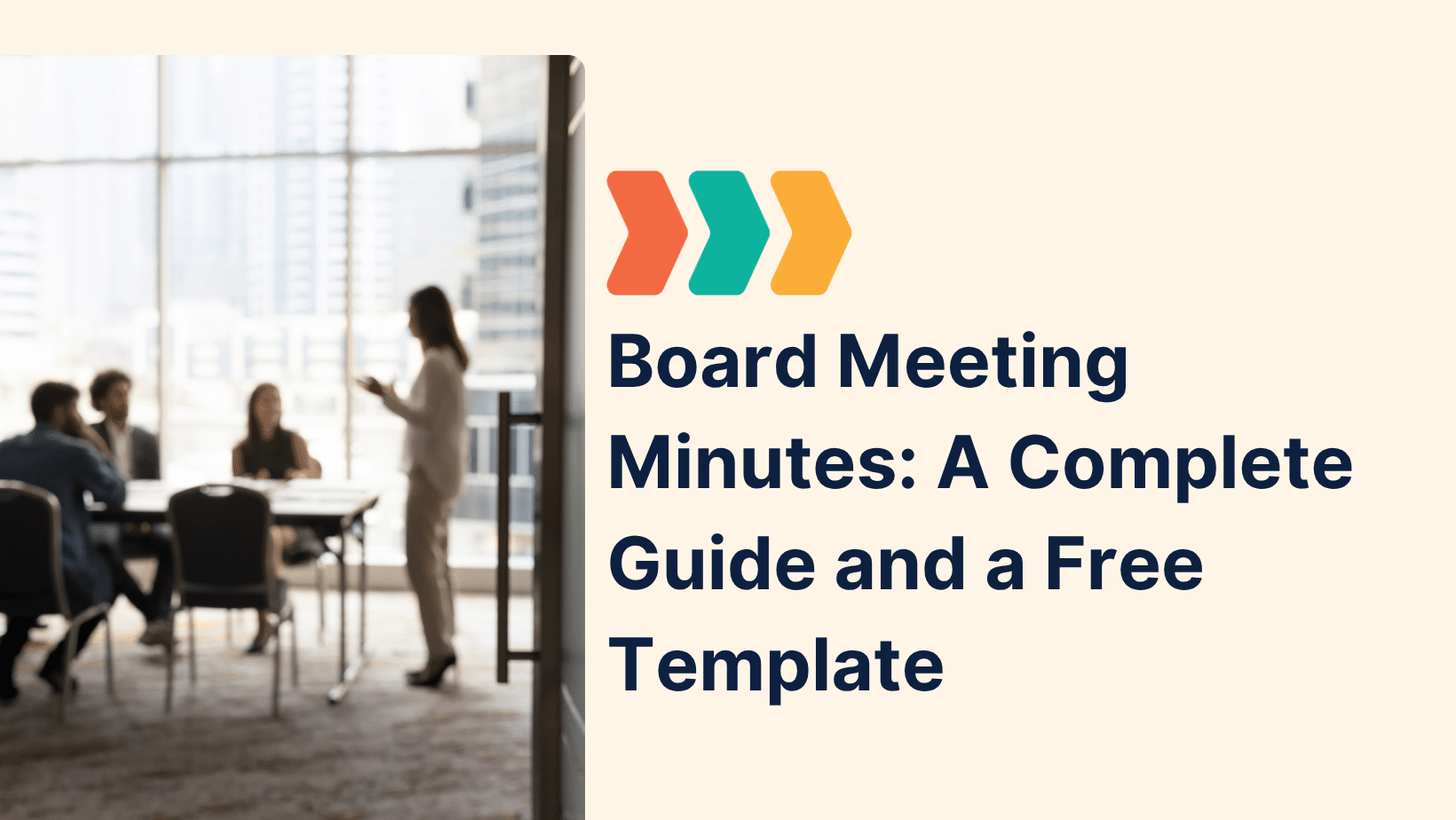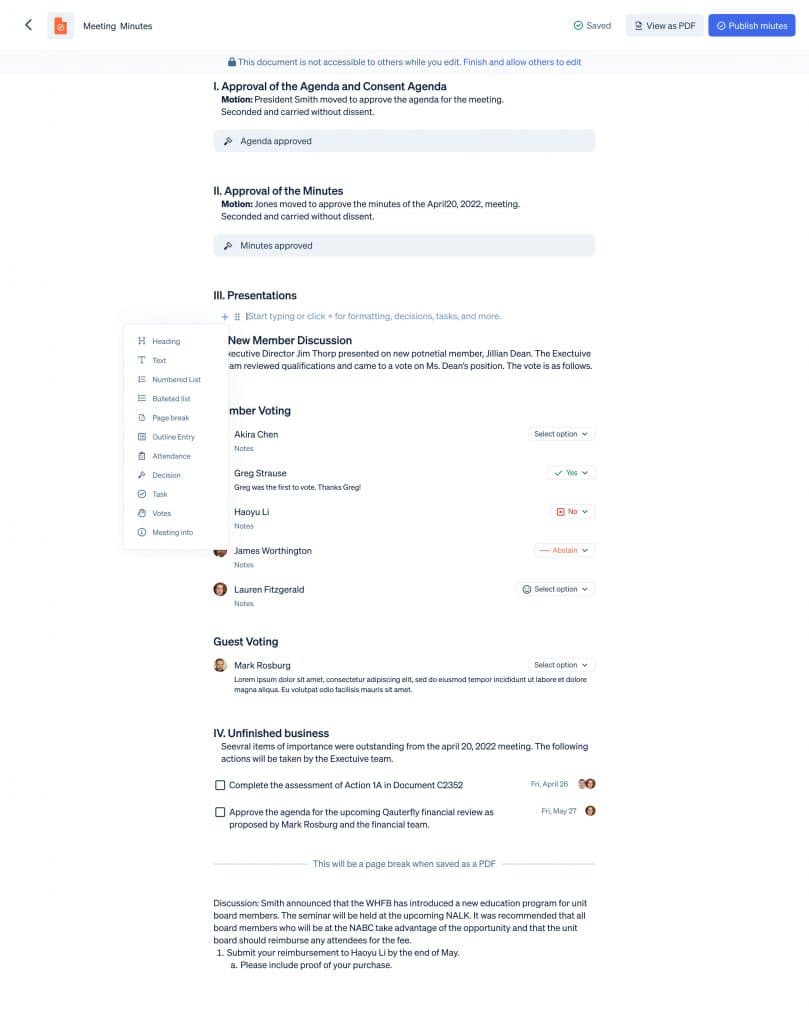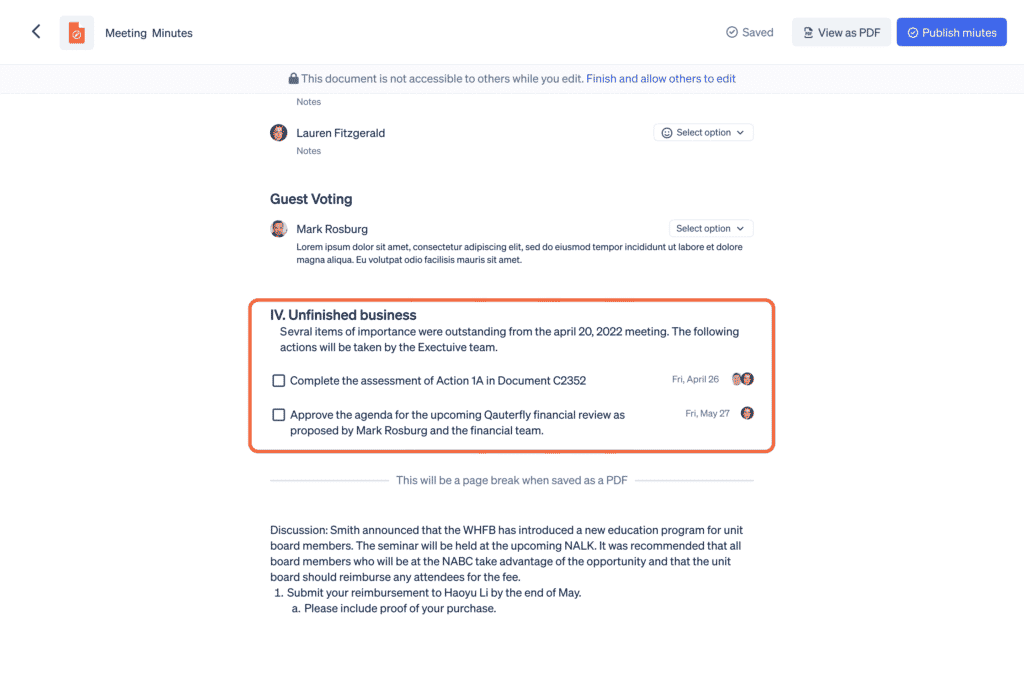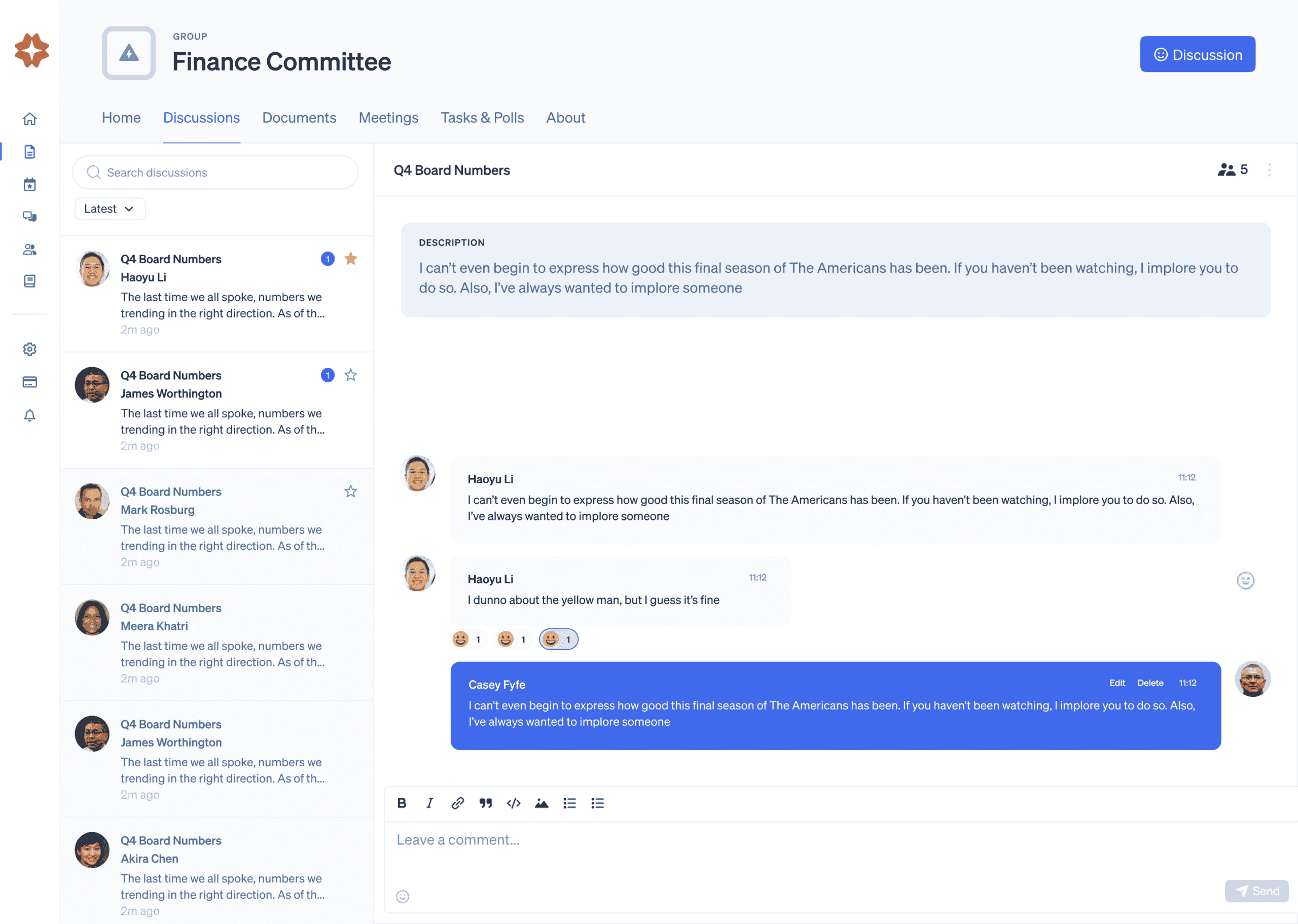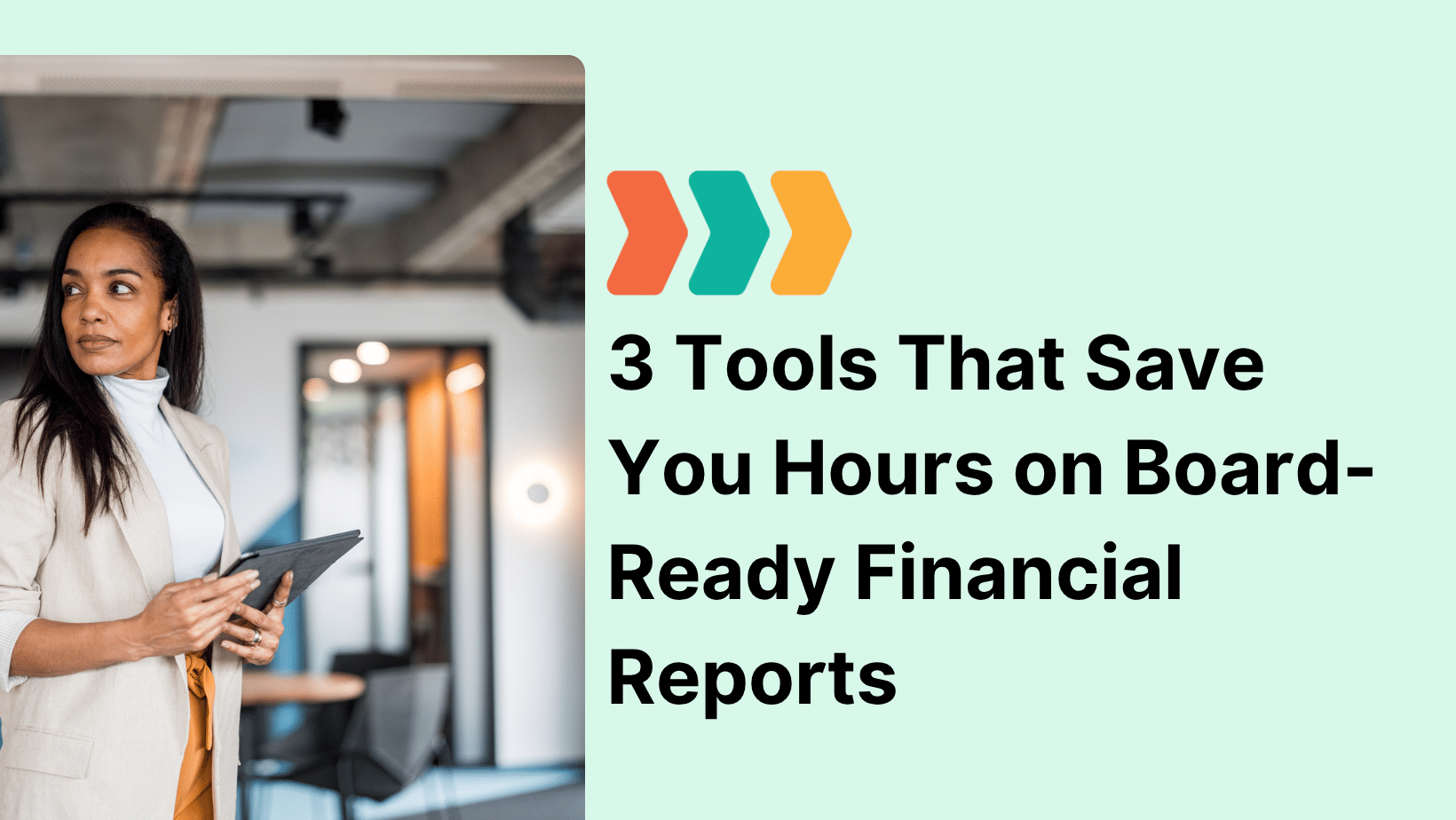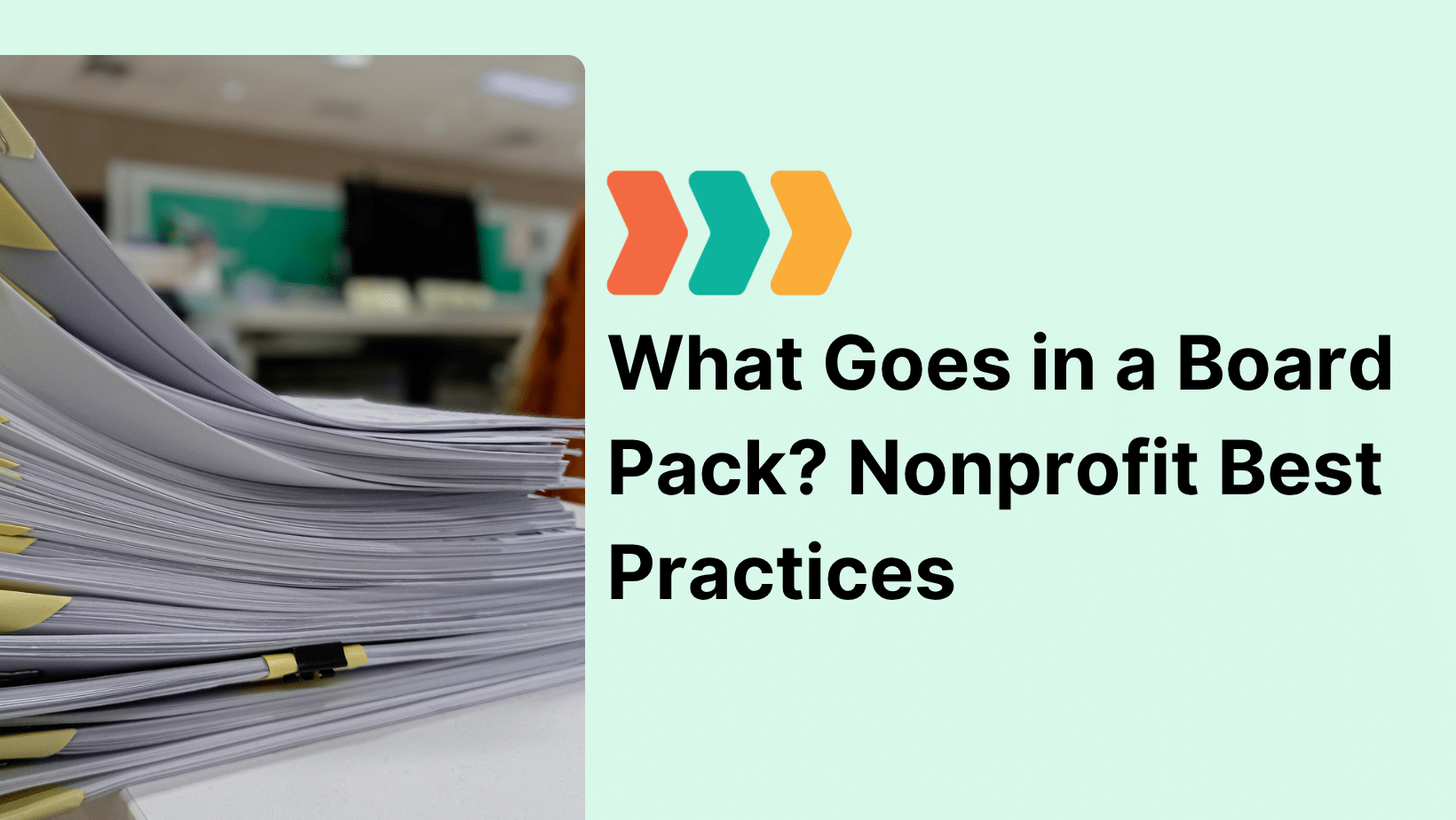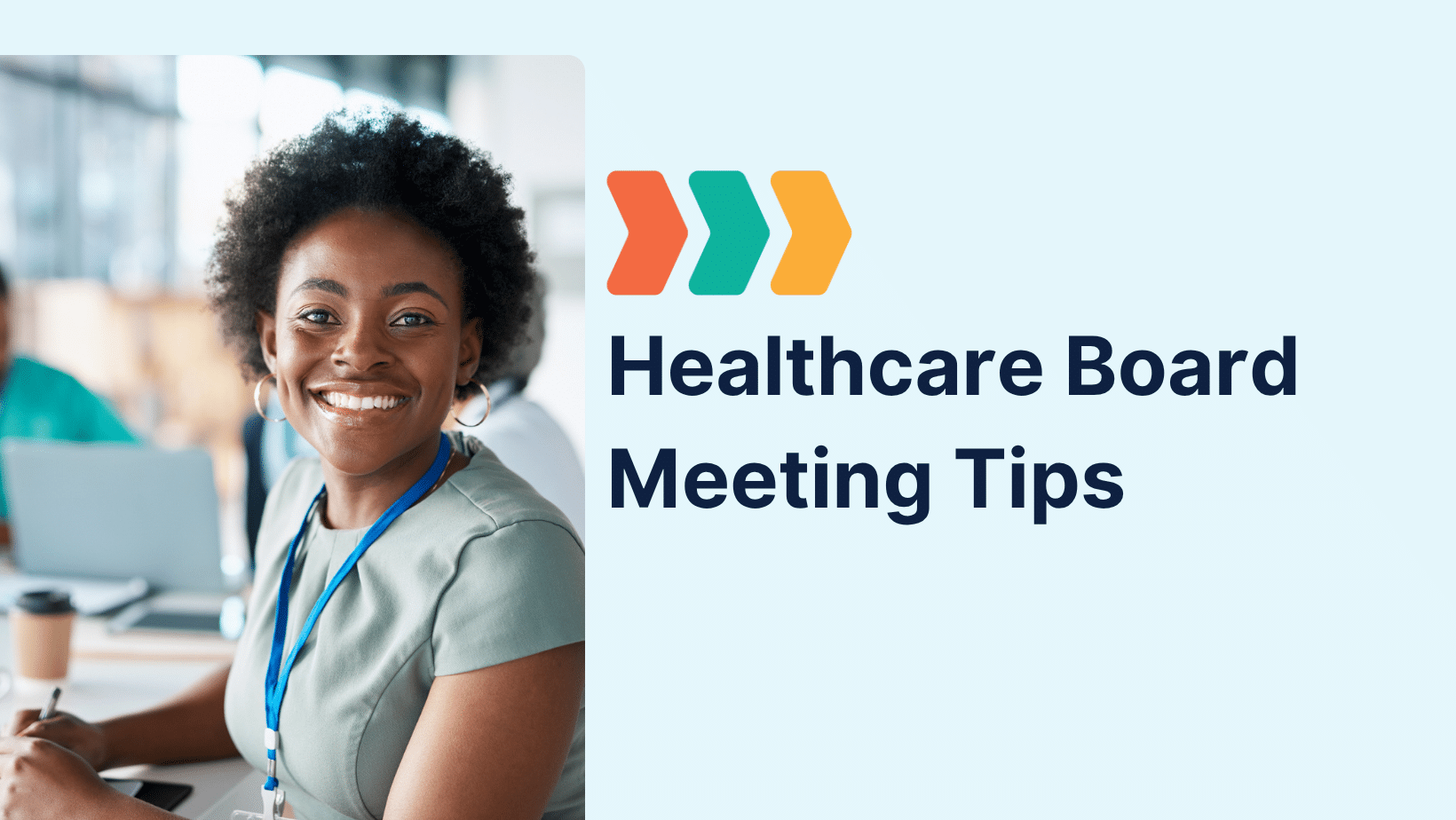Taking board meeting minutes can feel like juggling chainsaws—while also trying to listen, synthesize, and stay legally compliant. Whoever sits in that hot-seat must capture the rapid-fire discussion in a concise, accurate record that truly reflects the room’s energy and intent.
Yet it’s easy to underestimate just how mission-critical minutes are. They form the institutional memory that future boards rely on and the legal evidence that courts or auditors may demand. Organizations with crips, detailed minutes have weathered legal challenges with confidence; those with vague notes haven’t been so lucky.
Whether you’re a board secretary or another board leader with a passion for organized documentation, you know that minute-keeping is often a thankless job. Learning how to take effective minutes at a board meeting is worth the time and energy, though.
That’s why the governance experts at Boardable have put together this complete guide as a way for you to improve your board meeting minutes and get back to focusing on actually leading the organization. We’ll review the basics to make sure we’re all on the same page before getting down to the nitty-gritty details. Here’s what we’ll cover:
- What Are Board Meeting Minutes?
- What Are The Benefits of Board Meeting Minutes?
- How to Take Minutes at a Board Meeting
- What Not to Include in Board Meeting Minutes
- A Free Board Meeting Minutes Template
- How Board Minutes Tools Can Help

1. What Are Board Meeting Minutes?
Board meeting minutes are the official legal record of the board of directors’ actions and decisions. They document who met, when, what was discussed, how key motions fared, and critically, why directors chose a course of action. That means they should include more than a simple overview of discussions. The core purpose of board meeting minutes is to show that the board members did the following:
- Followed relevant procedures.
- Complied with state laws pertaining to your type of organization.
- Obeyed the organization’s own bylaws and aligned decisions with its mission.
In essence, board meeting minutes are great notes that capture all of your board meeting’s most important details. Let’s take a deep dive into what these details include, so you can start creating more effective board meeting minutes rather than just reading about what they are.

2. Why Do You Need to Take Board Meeting Minutes?
So you know what board meeting minutes are, but more importantly, why is it worth the time and effort to take great notes?
As we’ve mentioned, board minutes document that a meeting did in fact occur, but it goes beyond that. Before you can take effective board minutes yourself, you need to understand why you’re spending so much time documenting all relevant actions and conversations. Otherwise, you might find yourself wondering why you’re wasting your focus on perfecting your note-taking skills.
The purpose behind taking exceptional board minutes boils down to these core benefits:
- Once approved, board minutes become a legal record of what occurred in the meeting. In the event of a lawsuit, board meeting minutes can be subpoenaed, and board members may be held liable. If important details are missing or if votes are recorded incorrectly, your organization can potentially face serious legal ramifications. While it’s unlikely that this will happen, it’s always best to be prepared.
- Effective board meeting minutes serve as a reference point for future decision-making. Decisions are part of being a board member. Make sure you can reflect back on past ones by writing down what was addressed in the meeting, who said what, what the designated next steps were, and who is taking responsibility for which upcoming projects.
- Prospective sponsors, donors, and other funders can access board meeting minutes. As board leaders, we must understand our duty to supply our organizations with sufficient resources. Funders use board minutes to determine how effective the board is in leading the organization toward its goals. In other words, you don’t want someone to decide against financially supporting your cause because of poorly-taken notes.
Pro tip: Add a five-minute “Action Items Review” at the top of every agenda to close the loop from the prior meeting.
Board meeting minutes are an important resource, not just for future reference by the board itself but also for legal purposes. The power of great documentation extends even further, but these three reasons should be your main purposes for investing time and resources into better minutes-taking. Now, let’s dive into best practices for creating coherent, well-organized board minutes.

3. How to Take Minutes at a Board Meeting
Now, for the question that we all want the answer to: how can you create board meeting minutes that capture every key detail without writing a complete transcript?
It’d be great if we could jot down a few notes and call it a day, but your board minutes need to be comprehensive. Creating complete board meeting minutes that meet the needs of everyone who uses them is crucial for effective decision-making and record-keeping at your organization.
While there’s no one-size-fits-all approach for taking effective board minutes, we’ve found that a lot of great secretaries use a few common practices. The result? A clear and accurate account of your board’s actions. Let’s take a look at a few of those strategies:
1. Use Your Agenda As A Board Meeting Template
One of the keys to running productive board meetings is proper planning. Many board administrators create an outline for the minutes that are blended with the agenda a few days before the meeting. Taking board minutes becomes incredibly straightforward and much less prone to error this way.
One trick to try is using the meeting agenda as a template. It’s a great way to outline everything ahead of time, so your board members can keep the conversation moving without waiting on the secretary to catch up. Your secretary can spend more time listening and accurately capturing the conversation, rather than trying to start from scratch and record everything on the fly.
2. Assign A Minute-Taker Ahead Of Time
Picture this: you show up to your board meeting only to find out that no one wants to take minutes. Putting a board member on the spot could come as an unpleasant surprise. In fact, this will almost certainly compromise the quality of that board member’s engagement and participation levels. It could even go as far as to compromise the quality of the board minutes. That’s why you should always have a minute-taker lined up ahead of time.
Have the same person take board minutes at every meeting. Then, designate a backup person to take them for when the regular minute-taker can’t make it. This will almost always lead to stronger, clearer board minutes, because your notetaker will have time to familiarize themselves with the process.
3. Build-Out Expectations for Board Minutes
You have a designated minutes-taker. That’s enough to start taking more effective board minutes, right? Not quite! You might want to lay down a few ground rules for this person, such as:
- What format should be used – Your organization might stick to a particular format for board minutes. Maybe it changes with each new chair. Maybe it’s a perfected tradition passed down from future generations of secretaries. It all depends on your board. Include some basic information in your structure, like how to record motions and votes. Using past board minutes as a template can be an effective option.
- How they should take minutes – Most opt for a Minutes Maker platform like the one within Boardable. However, even after investing in a platform, your technology is only efficient if you use it effectively. The minutes-taker should know how to operate the board minutes system. During the meeting is not the optimal time to learn how to use these tools, so be sure your minute-taker undergoes training and is familiar with them beforehand.
- Whether they should participate – Some boards encourage their minutes-taker to participate. Others ask them not to. It depends on one thing: if they’re a board member. If not, they shouldn’t participate unless expressly invited.
This might seem like a lot of guidance. However, sharing these expectations upfront will help whoever is taking the board meeting minutes to create standout notes.
3. Write In An Objective Voice
Your board secretary should always remember that board meeting minutes must be written objectively. When you encounter controversial issues or contentious votes, attempt to summarize the debates and arguments without adding unnecessary comments or judgments. Weed out emotional statements by following these suggestions:
- Stick to the facts, including votes in favor of a motion, votes against a motion, abstentions, and pertinent details about discussions. Listen carefully to the main topics and document significant portions of the discussion.
- Ask a third party—someone who is not on the board—to read the board minutes to give you an unbiased opinion. When doing so, make sure the third party is not privy to any confidential information. Ideally, you can ask someone like the executive director or a staff member.
- Re-read them the next day. Since the secretary is also a voting board member, recording information objectively can be challenging. If you’re unsure if your board minutes are objective, sleep on it and re-read them the next day with a fresh mind.
By following these tips to ensure objectivity, you’ll create unbiased notes that capture essential information for future reference. Otherwise, letting opinions creep into your board minutes can impact your note’s authority and professionalism.
4. Include Pertinent Details
Board meeting minutes are a matter of law for organizations. They serve as the official record to show that the meeting was actually held and important matters were discussed. As such, it’s always important to capture all necessary details.
While there are no legal rules for what information board meeting minutes must include, most boards base their outlines on Robert’s Rules of Order. Full use of these extensive rules would be cumbersome for most organizations, but limited-use can be helpful in maintaining order and quickly addressing agenda items. When following Robert’s Rules of Order, board minutes must include:
- The type of meeting
- The date, time, and location of the meeting
- A list of attendees, including nonvoting participants with their names, titles, and reasons for attending
- When the meeting was called to order and when it was adjourned
- A record of motions, seconds, and whether or not the motion passed
Overall, aim to create board meeting minutes that are specific enough to capture the board’s focus and decisions, but not so sparse that you can’t decipher what actually occurred during the meeting a few months down the line. Plus, scant board minutes could open up the board to liability issues, so you never want them to be so minimal that they raise suspicion.
Think of it this way: major decisions and discussion points should always be captured but in a “short and sweet” fashion.
5. Proofread and Share Minutes Securely
When all is said and done, you’ll want to review your board meeting minutes before sharing them. Be sure they’re consistently formatted and presented. If there are additional notes that need to be rewritten into the minutes, see to it promptly after the meeting.
From here, board minutes should be finalized and distributed to attendees as soon as possible while the meeting is still fresh in the board and minute-taker’s memory. As we’ll explore later on, Boardable’s Minutes Maker empowers you to securely share your minutes within seconds. With expansive document storage capabilities, you can allow board members to access board meeting minutes, the agenda, and any other pertinent documents.

4. What Not to Include in Board Meeting Minutes
Knowing what to leave out of board meeting minutes is just as significant as knowing what to include. Remember, a lot rides on the minutes, and recording the wrong things can cause skepticism among stakeholders, legal entities, and others.
With this in mind, let’s explore five things secretaries commonly record in their board minutes but shouldn’t:
1. Don’t Include How Individuals Voted
In each of your board meetings, you’ll likely have a handful of items that need to be voted on. While you should name who made and seconded the motion, you shouldn’t include how individuals voted. Exclude their names and simply note the number of those in favor, those against, and those who abstained. As a general rule, keep the record impersonal.
However, there is an exception to this rule. If financial transactions involving board members come up or if the executive director’s pay is set, let the board meeting minutes reflect how individuals voted and their rationales. In the event of any legal challenges, rationales will support reasonability.
RELATED: There’s a lot more to voting than what’s reflected in the board minutes. If you want to learn more about refining your voting process, check out our board voting guide, another complete playbook put together by the Boardable team!
2. Don’t Include Particular Board Members’ Opinions
As previously mentioned, your board meeting minutes should be unbiased. Because of this, board minutes should focus on decisions, not discussion.
On occasion, disagreeing members may state flat-out that they want their disagreement recorded. Avoid this, and instead, simply note that it occurred—no further explanation is necessary.
Similarly, if there was a debate, mention it, but don’t make opinionated notations. After all, board meeting minutes are discoverable papers that can be used in any potential legal situation. The last thing you want is to unnecessarily open your board up to liability by not sticking to the facts.
3. Don’t Include Summaries of Documents or Presentations
Between bylaws, annual budgets, and new organizational policies, boards of directors review a lot of important documents. Anytime you review a document in a meeting, you should mention presented materials in your board minutes. However, don’t go into great detail about its content. Instead, note where it’s obtainable, so members don’t have to rifle through excess information in the meeting minutes.
With comprehensive tools, presentations are easy to locate at any point. Specifically, with solutions like Boardable’s Document Center, you can organize and store pertinent records, presentations, and other documents alongside your board meeting minutes.
Plus, Boardable is compatible with widely-used cloud-based storage systems like Dropbox, Google Drive, and OneDrive. That makes it easy to have a centralized location that stores and links out to all the resources your board needs.
4. Don’t Include Things That Could Subject A Tax-Exempt Entity To Scrutiny
While there are common distractions in every board meeting, recording them can be problematic in a legal investigation. You’ll want to exclude these distractions. For example, leave out the following from your board minutes:
- Praise or displeasure
- Small talk or political banter
- Negative spin
- Unnecessary legal terms
When in doubt, leave it out. This goes for anything that could present complications if reviewed later by others. If legal commentary was made or if the organization’s lawyer advised the board, simply note that this occurred in the board minutes. Don’t record the substance of the legal advice.
5. Don’t Include Off-The-Record Conversations
Side discussions are bound to happen, but they shouldn’t be recorded. These off-the-record comments and discussions are certainly allowed to take place, but they must be clearly designated as off-the-record. If a board member brings up an issue that’s worth clarifying but doesn’t appear in the agenda, it doesn’t normally need to be detailed in the board minutes.
Instead, note that directors took the time to discuss items that weren’t on the agenda. Nothing else should be recorded about any tangents.
To avoid these complications, create an Agenda Requests folder in your Document Center. This way, future discussion topics are correctly scheduled into future meetings.

5. Board Meeting Minutes Template
While the content of your board minutes will change from one meeting to the next, following a standard outline will help the minute-taking process to ensure consistency and accuracy. There’s no “right way” to draft board meeting minutes, and each organization has its own preferences for what effective ones look like. However, there are several board meeting minutes examples that can illustrate what directors need to record during meetings.
If you’re new to the process, you’re likely unfamiliar with these components, and you may be unsure of where to start when creating a reusable outline. To help, we’ve created a board meeting minutes template that’s based on Robert’s Rules of Order and can be emulated to take notes during your organization’s meetings:
In-Text Board Meeting Minutes Template
If you’re unable to view the above board meeting minutes template, here’s a breakdown of the basic elements the outline addresses:
- Opening the meeting: take attendance and include the date and time the meeting started
- Old business: approve the previous meeting’s minutes and discuss unresolved issues from previous meetings
- New business: officers and committee chairs deliver their reports and any other agenda items are addressed
- Closing the meeting: include the time of adjournment, information regarding the next meeting, and the secretary and president’s signatures
While the above board meeting minutes template will serve as a solid starting point, you’ll need to adapt it to suit your board’s exact needs. With an outline to follow, you’ll set your team up for success and ensure all important discussions and motions are recorded in a cohesive, clear, and consistent way during meetings.
While creating a board meeting minutes template manually may work, it’s not optimal. That’s why Boardable comes equipped with helpful tools that empower you to record minutes directly within your agendas.

6. How Technology & AI Streamline Minute-Taking
Manual minute-taking steals valuable focus. As you know, capturing every motion, vote, and action item demands unwavering attention to detail, but the right technology can shoulder that burden for you. By solidifying your digital strategy and investing in dedicated tools like Boardable’s Minutes Maker, you can distribute completed, compliant minutes just moments after the meeting ends, whether you’re gathering in person, remotely or a hybrid of the two.
Minutes Maker stands out because it blends smart automation with a workflow your board already understands. Minutes Maker + AI tags motions, assigns tasks, and drafts clear summaries in real time, so you never scramble to capture the essentials. Its agenda-linked note-taking lets you type directly into the outline you built beforehand, ensuring no section is missed. Thanks to task automation, every action item you log instantly appears on the responsible member’s dashboard as a reminder, turning promises into progress without extra follow-up.
Plus, sharing your board minutes has never been easier! Once you’ve finalized them and gotten them signed off on using our e-signing tools, publish them and instantly distribute them to your desired audience. You can choose to make board meeting minutes public if desired, and they’re always associated with the meeting and its attendees. You can choose to save a record in your Document Center or email a PDF, keeping everyone updated.
In short, Minutes Maker transforms a high-stakes, time-consuming chore into a streamlined, auditable process—freeing you and your board to focus on mission-critical decisions instead of paperwork.
Best of all, you can connect the minutes, agenda, and tasks of past meetings with the materials for the next one, which makes approval, review, and preparation for upcoming discussions a breeze! Take a look at how simple it is to group meeting information together:
Using dedicated board management tools can help protect your board from liability and inefficiency by ensuring you catch all vital details. Let Boardable do the heavy-lifting, so you can focus on producing effective minutes that effectively capture your meetings.
Wrapping Up The Discussion on Board Meeting Minutes
Great minutes bridge the gap between discussion and action. By standardizing your process, leveraging smart tools, and focusing on clarity, you’ll keep your board compliant, informed, and ready for what’s next.
If you’re unsure where to start when documenting your next meeting, feel free to build out your minutes using the above board meeting minutes template. For a more tailored approach, our powerful board software and intuitive Minutes Maker tool will streamline the process further, ensuring you capture all essential discussion points, votes, and assignments.
Ready to reclaim hours each month? Request a demo of Boardable and experience AI-powered minute-taking firsthand.
